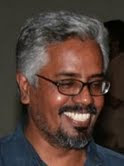CHOTA MUMBAI

Stuffing up Kochi as Mumbai
In Anwar Rasheed's film, 'Chota Mumbai', the erstwhile soft-porn queen of Malayalam cinema, Shakeela makes a cameo appearance. She appears as herself and is in Kochi for the shooting of a film starring her. The Superstar of then and now, Mohanlal who plays the leader of gang of street goondas, along with his comic duo Jagathy Sreekumar and Co come together to give protection to Shakeela and the shooting crew. A crowd of ogling men gather at the location to steal a glance at their sex idol. Eventually, the 'proper stars' Mohanlal, Siddhique, and Jagathy themselves also pose with Shakeela to take their snaps with her. The superstar even inveigles his way into the cast of the film to make physical contact with her. Ironically, Shakeela disppoints the oglers by appearing in the dress of a demure Malayalee woman, though it doesn't dissuade her fans from thronging up to her. But as the film moves on, one wonders why does she appears as herself in a film of this sort which features a proper Superstar?
One major reason is that she is passe and no longer a threat; evidently, she is past her prime in her career and in malayalam cinema. Once a real threat, now turned into a butt of ridicule!. The other reason could be that her image is something that definitively vibe with and easily evoke the 'low life' image that the superstar is playing in the film. In the film, Mohanlal plays the role of a small time goonda who does odd jobs (though in the film we only see him intervening to free his friends from the clutches of either the rival gangs or the police). He is the son of a wrestler and leader of a gang of four who all belong to the streets of Kochi. Apparently, he is of no use to the family, and occupies a space that is neither within or without the family. He is a good-for nothing who floats along with his gang with nothing substantial ahead of them in terms of money or livelihood. Naturally, the film ends when he marries a proper girl and takes up a regular vocation.
In one funny situation that characterises their condition, we see the gang sitting sad and tense in a slum at dusk. In the earlier scene, the hero has been evicted from home by his father, after their house has been attached against an advance taken by the hero without father's knowledge. As it turns out, the tense wait of the gang is only for a bottle of liquor, as it is a dry day. In many other situations like this, the 'anti-heroism' of the hero is brought out repeatedly. Obviously only such a hero, who is the lowliest of the low, with no link to the 'normal' decent life of malayalee can team up to protect Shakeela. The Shakeela scene thus acts as a condescending pun on 'Shakeela culture', one that the hero himself is part of within the narrative. Trying to tell the story of an 'non-hero' the film has nothing to rely upon but myths and phantoms like this. Yet another myth is that of the 'Kochi underworld' which our young filmmakers are dying to imagine up as yet another Mumbai-like city with a 'proper' underworld a la Ram Gopal Varma!
And it is exactly this obsessive need for mythologising that hollows out the narrative or tries to substitute for it that makes the film into an absurd and extended animation of stuffed characters played by bloating, aged male actors.
Labels: malayalam cinema


0 Comments:
Post a Comment
Subscribe to Post Comments [Atom]
<< Home